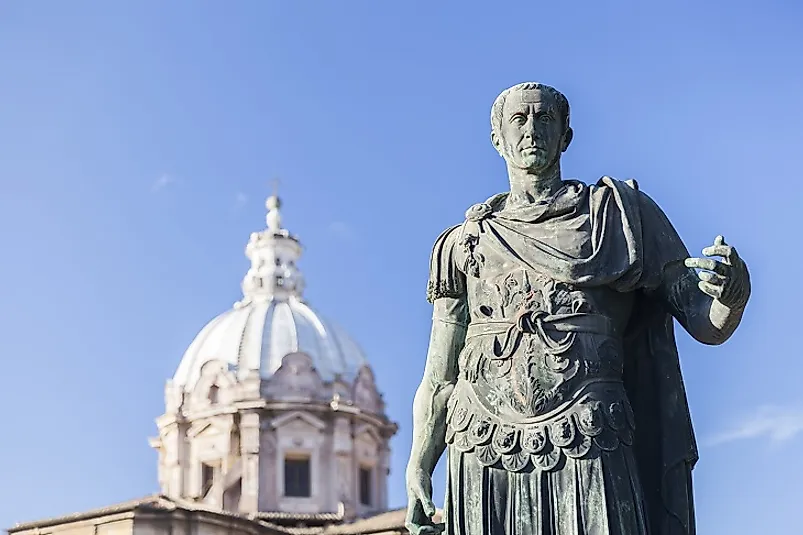The Roman Empire: 27 BCE to 4th Century AD

5. Formation
In the First Century BCE, the Roman Republic was in chaos and civil war was brewing and, amidst all of this, Julius Caesar was proclaimed dictator of the Roman Republic by the Senate. However, Caesar did not enjoy the full support of the Senate members and, in 44 BCE, powerful senators assassinated him inside the Senate forum. For a time, chaos continued to engulf Rome, with more executions taking place as civil war raged on. By this time, Octavian, the adopted son of Caesar, was in Actium fighting the rebellion led by Antony and Cleopatra. Octavian would end up successfully defeating them in that same battle. The victory at Actium enabled Octavian to annex Egypt to the Roman Republic. Returning to Rome, Octavian was rewarded by the Senate the title of Emperor and name of Augustus.
4. Rise To Prominence
The Roman Republic crumbled, and ushered in the Roman Empire which, by some definitions, lasted for 1400 years. In 27 BCE, Octavian was the first of the Julio-Claudians to rule Rome with diplomacy. Gaius Julius Caesar Octavianus was now Augustus, and he reigned from 27 BC to 14 AD. Tiberius followed Octavian's peaceful diplomatic reign from 14 AD to 37 AD. The first two hundred years of the empire were generally marked with peace and stability. Caligula reigned from 37 AD to 41 AD, but was assassinated in 42 AD. Claudius reigned from 41 AD to 54 AD, and was favored by the Praetorian Guards. Nero reigned from 54 AD to 68 AD until he committed suicide. Turmoil reigned after Nero's death, and once against the threat of civil wars and rebellions dominated the empire. Thus, this ended the Julio-Claudian Dynasty.
3. Challenges
The Roman Empire was now in total chaos, as civil strife engulfed its provinces and colonies. The Year of the Four Emperors was iconic of, and followed, amidst all of this chaos. In 69 AD, one of the legionary generals Vespasian succeeded in winning the civil wars and the new reign of the Flavian Dynasty began. Two of his sons succeeded him. The first was Titus, whose reign was short, and then Domitian, who had a long reign, but was himself eventually assassinated. Next came the Nerva-Antonine Dynasty, ruled by the five "good" emperors that gave peace and prosperity back to Rome. The Severans and the Soldier-Emperors (193 AD-284 AD) began their own ruling era following Severus's seizing of power. Next were the Diocletian, Constantine, and Late Empire (284 AD-476 AD) periods.
2. Demise
The decline of the Roman Empire started with the reign of Severus, which triggered the Crisis of the Third Century in 235 AD after his assassination. The following 50 years were chaotic, and a time that saw the Senate appoint 26 different men as Emperors of Rome. Emperor Diocletian next came to power, and he initiated the Tetrarchy that had four emperors appointed to rule Rome from different imperial divisions. However, civil war soon developed. After the civil war, Constantine I ruled the Roman Empire and divided it into two divisions. These were the Eastern Empire, with Constantinople (in modern-day Turkey as its capital, and the Western Empire, which maintained Rome as its own capital. The Eastern (or Byzantine) Empire lasted for around another thousand years, while the Western division soon fell prey to the invading Visigoths in 476 AD. However, in 1453, the Eastern Empire ultimately fell as well, succumbing to the powerful Ottoman invasion.
1. Legacy In History
The Roman Empire left a legacy of confusing claims to the remnants of Imperial Rome. Supposed successors to the title of "Caesar Emperator" ranged from the Holy Roman Emperor, the Russian Tzars, the Ottoman Mehmet II, and even Mussolini in the 20th Century. Today, the Eastern Roman Empire's concept of state, its incorporation of Greek culture and language, and the Orthodox Christian faith which it helped flourish are still observed by many European countries. Roman Law was the basis for many modern laws being observed today in many countries as well. The republican government in many modern countries was patterned after the concept of the Roman Republic. Roman inventions still influential today included roads, aqueducts, baths, heating systems, and concrete. Other historically relevant innovations included high-rise construction, glass works, military discipline, and proper practices in medicine.











